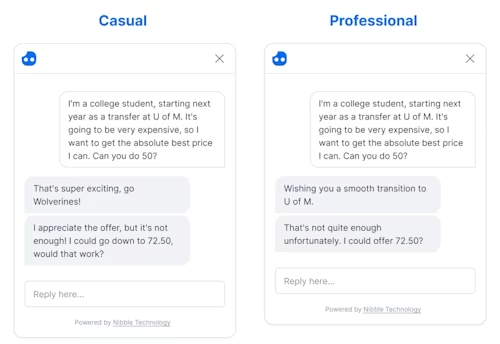
Using AI to Create a Great Customer Experience
This clever chatbot helps e-commerce sellers and buyers agree on a price.
Table of contents

🕒 Reading time: 7 minutes
The Art of Agreement is a series of unique perspectives from leaders and creators on the universal truths and tactics that get humans to agree. Check out the rest of the series:
Reaching Agreement with Radical Candor - featuring Kim Scott, best-selling author
The Art of Resolving Disputes - featuring Jennifer Lupo, Mediator
Using AI to Reach Agreement - featuring Martin Rand, CEO, Pactum
Creating Agreements You Can Actually Understand - featuring Bob Sutton, Professor Emeritus, Stanford
Great customer experience is all about making it easy for people to reach agreement, and it turns out AI can be pretty good at it.
More than 200 e-commerce sellers are using an AI-powered chatbot created by UK-based Nibble Technology to negotiate with customers while also creating a better, more engaging customer experience.
Nibble co-founders Jamie Ettedgui and Rosie Bailey met while studying in a masters program at London Business School. Their chatbot has a playful personality—as I discovered when I did a demo and kept tossing lowball offers. “Is there an echo in here?” the little smart aleck responds when you repeat the same offer. “Am I repeating myself?”
Nibble’s core value proposition: retailers get better margins, and customers get a better experience.
What kind of companies are using Nibble?
Jamie: At the moment we work with a lot of e-commerce. There’s a men’s casual wear company. Lots of beauty brands. Lots of furniture and consumer electronics. Now we’re also having conversations to handle negotiations for B2B sales.
The opportunity you identified was that retailers have been discounting more than they need to. Why are they doing that?
Jamie: In the retail industry discounting used to be much lighter than it is now. You'd start at 10%, 20%, 30% and then at the end maybe 50%. Now you see discounting that starts at 40% and goes up to 70%. Do you really need to discount that much? In your experience, as a customer, you might see something in a store that is marked 30% off, but would probably have been happy with 25% off. So the store didn’t need to discount so much. It’s all about finding the right amount of discounting and then creating win-win. That’s the essence of a good negotiation.
What causes that over-discounting?
Rosie: There's deep complexity in their business model. For example, what happens if the shipping containers from China are suddenly 20% more expensive? Or they're stuck in the Suez Canal? So it's not just how much you order, it's how quickly things arrive, and do they arrive for the right season. Most of the people we speak to feel like Black Friday is a huge own goal where they have to satisfy four times their average monthly demand on one day. Things like that make it really hard to get the right amount of stock in the right place at the right time.
“People value a negotiated purchase more than just a fixed discount purchase. So by using chatbots, you’re creating a very happy, positive brand experience.”
When an e-commerce company uses Nibble, its customers get less of a discount, yet at the same time they have a better experience. How does that happen?
Rosie: A lot of academic research shows that people value a negotiated purchase more than just a fixed discount purchase. So by using chatbots, you’re creating a very happy, very positive brand experience. And at the end of it, the customer has agreed to, let's say, a 6% discount instead of a 20% discount. But they’re still getting a discount. So everybody's happy, right? The customer is happy because they feel like they've got a good deal. They've really engaged with the brand, and they feel listened to. And the brand isn't having to knock 20% off the headline number. So it’s about discounting the right way and making it much more personal. And the repeat order rate from customers who use Nibble is about 10% higher.
Teaching AI to Get Sassy
Do consumers like negotiating with a chatbot?
Rosie: Whenever we’ve asked consumers the question, “Do you like negotiating,” we get a broadly 50-50 response, particularly in the UK and the US. When you let people play with Nibble and you ask them if they prefer that experience, 85% say yes. It’s because they're not embarrassed. There's nothing to fear if you get it wrong. It’s fearless. It's fun, and positive. There’s no loss, no cost.
How do you train the chatbot?
Jamie: All of the negotiation decisions are based on academic theory, behavioral science and negotiation theory. It’s really well researched. And as we gather more data, the AI gets better and better.
Rosie: But it's not all about AI. There’s an emotional component. That is really central and core to what we do. It’s much, much more than pricing algorithms. We do 25,000 negotiations a month where we know nothing about the individual who's negotiating with us. All we can do is read their engagement, their appetite. So that emotive part of it is really, really important to us. The way we make decisions as humans is inherently irrational. So our chatbot is designed to help you make decisions, but in a very human centric way. And then the analytics comes second. As we do enough negotiations, it becomes a self-reinforcing loop.
Speaking of that emotional component—I’ve noticed that your chatbot can be a little bit sassy.
Rosie: Sometimes potential clients will test it out, and they’re like you, they’re trying to see how tough they can be. We sometimes get clients who come to us and say, I did think I wanted your chatbot, but it's too sassy. They’re basically saying, I want to be rude to the bot and have the bot be lovely back to me. We tell them, look, it's only sassy to you because you were sassy to it. But oddly enough, that behavior is very different from what we see with real customer implementations. Because when you’re a real shopper, you’re not playing around, or trying to test it. You’re in a rush. You want the item. You put in the price that you're willing to pay, and you try to get to a deal as quickly as you can.
Bots Doing Work at Scale
How does the chatbot use negotiation science to reach agreement?
Jamie: Some of the basic stuff about negotiation theory can be learned. One example is that it’s very powerful to anchor the negotiation around a number that you're happy to agree on. Most academics agree that you should always go first. You should always put your number on the table first. That's the single most valuable thing you can do in a negotiation. The key is you need to go first with the number that you know you're happy with. Then the rest of the conversation will all be about the salesperson trying to persuade you to come towards their number, and that's what you want the conversation to be about. You don't want to be in the position of trying to persuade the salesman to get down to your number.
Could your chatbot be used to work alongside humans?
Rosie: We've been talking with some people about that and we think that we think there are some use cases in that. Some big companies that are conducting complex negotiations, which might take three to six months, might see a different value in a co-pilot. If the co-pilot is positive and engaging, you won't need to mandate that salespeople use it—they'll want to use it. Once they do, the insights you will get into the stages of your negotiations will be much greater, and that data will help you make future decisions.
Jamie: But you're never going to replace all negotiation with AI. That's never going to happen. But there are so many pointless, quick negotiations that can be solved in 90 seconds, or five minutes. Things like renewing your broadband service, where you end up calling somebody who's just looking at a computer screen and has some variables they can play with. It’s a completely pointless exercise that doesn't need to be done by a human.

Your negotiation algorithm is not based on generative AI. But you’ve started using generative AI to complement the negotiation algorithm. Can you explain that?
Jamie: We have a new feature called Hybrid Atomic Copy. Let’s say there's a chat, and the customer says, “I want to buy this product for this price, and I want free delivery. And by the way, it's my wife's birthday.” We turn this into three elements. There's an offer, there's something about delivery, and there's something about birthday. Two of those items, the price and the delivery, we respond to with our fixed copy. But then we'll use generative AI to reply about the birthday: ”I hope she has a great birthday,” or something like that. So we create a new sentence where we've merged the three things together. We've named these things generative atoms. It's an atom that has nothing to do with the negotiation.
Rosie: We had one person who said, “Hey, I need a better deal. I'm just a student and I'm off to U of M next fall.” I'm an English person. I don't know what U of M means. It's very obvious to a North American, but for me it was not obvious and our chatbot just went, “Okay, you need a better deal. Perhaps you could accept X.” And the generative atom goes, “That's great news. Go Wolverines.” I had to look it up afterward and see what that meant. But that's awesome. It makes it much more friendly. It’s very cool.
DISCLAIMER. Content on this publication referring or hyperlinked to any products or service by trade name, trademark, supplier, or otherwise does not constitute or imply its endorsement, recommendation or validation by Docusign. This publication may not be used for advertising or product endorsement purposes unless expressly authorized by Docusign.

Dan Lyons is an author and recovering journalist who has written about technology, work and business transformation.
Related posts
Discover what's new with Docusign IAM or start with eSignature for free


